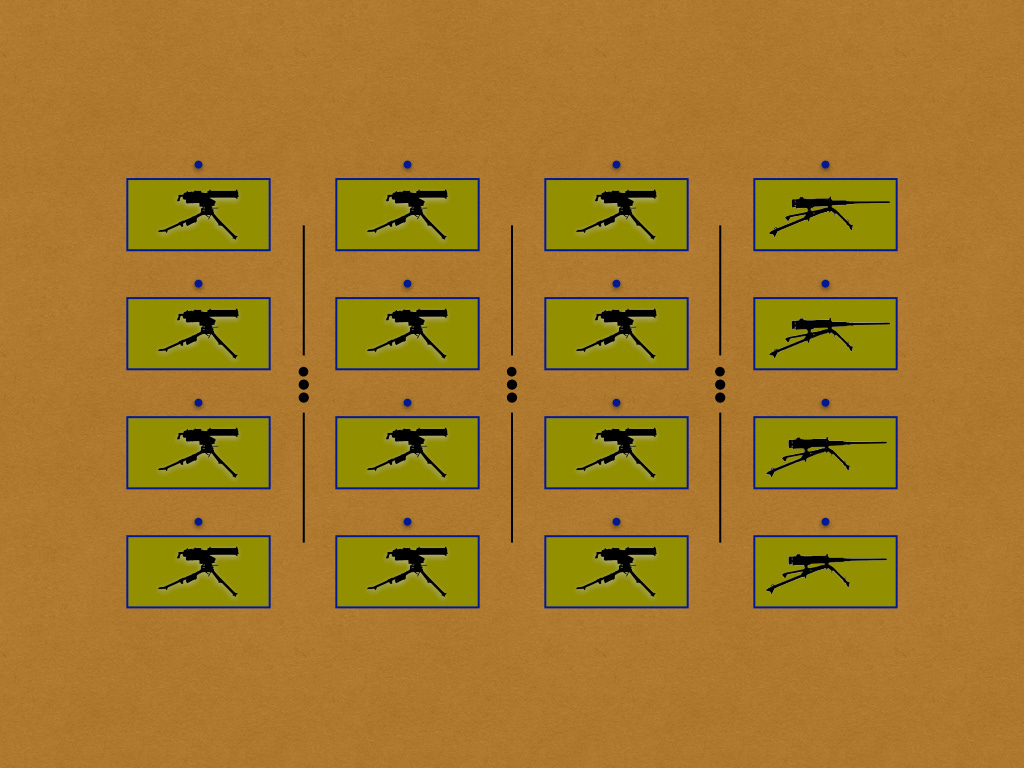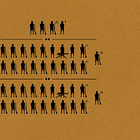In the proposal that he wrote in 1932, Major Patton imagined that the rifle companies that he designed would be assembled, by threes, into infantry battalions. These battalions, in turn, would come together to form composite infantry brigades, each of which consisted of three infantry battalions, a horse-drawn machine gun company, and a motorized field artillery battalion.
With four officers, six non-commissioned officers, and sixteen privates, the headquarters of each battalion might be described as a somewhat larger version of the headquarters of each of the rifle companies. Both types of headquarters element, for example, rated two cooks and two drivers (called “chauffeurs.”) The battalion headquarters, however, had twice as many officers, twice as many non-commissioned officers, and six times as many spare privates as the headquarters of a rifle company. (Called “basic privates” in one chart and “riflemen” in another, these seem to have served as guards, assistants to cooks and other specialists, and replacements for men absent from the combatant platoons.)
While all of the non-commissioned officers of the rifle companies, up to and including the first sergeant, wielded rifles, those of the headquarters of infantry battalions carried pistols. Unfortunately, as Major Patton declined to describe the duties of these corporals, sergeants, staff sergeants, and technical sergeants of the battalion headquarters, let alone the logic behind this difference.
Major Patton was even less forthcoming when it came to the internal organization of the “headquarters and headquarters company” of a composite infantry brigade. Indeed, the only information he provided was the ranks of the members of this fifty-three person company and the fact that every one of them wore a pistol.
The machine gun company, which made use of horse-drawn vehicles to carry both weapons and ammunition, was made up of four four-gun platoons. Of these, three were armed with water-cooled .30 caliber machine guns and one with air-cooled .50 caliber machine guns. The latter weapon, which had yet to enter series production, served as a means of defending against the lightly armored tanks of the early 1930s.
The field artillery battalion consisted of two four-gun batteries armed with 75mm field guns and one four-piece battery equipped with 75mm howitzers. Major Patton imagined that, while the field gun batteries would normally provide direct support to forward battalions at relatively long ranges, the howitzers would often be attached to infantry battalions, which would employ them as infantry guns or anti-tank weapons.
Marvelous to say, the composite infantry brigade described by Major Patton possessed no mortars at all. Thus, the four 75mm howitzers were the only crew-served high-angle of fire weapons in the formation.
Source: George S. Patton, Jr The Probable Characteristics of the Next War and the Organization, Tactics, and Equipment Necessary to Meet Them (Washington, DC: Army War College, 1932)
For Further Reading:














This is wild. A brigade almost completely focused on short range and short term close combat. Note the almost complete absence of sustainment units. Even if you assume some of the personnel with undefined duties are medics, supply personnel, mechanics and armorers, this organization would not be able to fight for very long. It would probably be able to fight for a few days, but it would run out of all internally available commodities and not be able to fix its own equipment unless resupplied and supported from outside organizations. Why horse drawn machine guns if your artillery battalion is motorized? And no scouts, mortars or radios? Seriously?
Kindly redo this proposal Major Patton and resubmit!
This screams of von Schell even more than the companies did. I don't remember if it was in The Soldier's Load or Battle Leadership, but I definitely remember von Schell criticizing mortars for maneuver elements